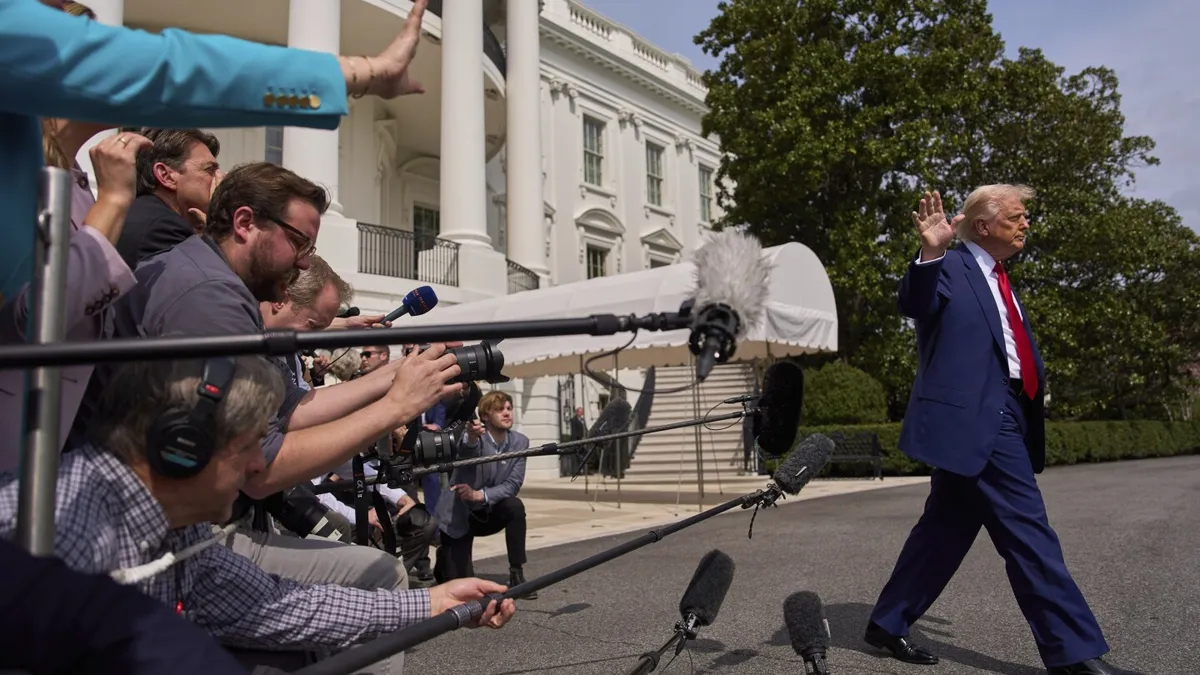
In a bold move that has sent shockwaves through international markets, President Donald Trump has initiated a trade war that threatens to reshape the global economy. The administration's new tariffs, affecting goods imported from a wide array of countries and territories, are projected to drastically increase the cost of everyday items, including cars, clothes, and computers. With tariffs reaching as high as 50%, the intention is to penalize nations that Trump claims impose unfair trade barriers, contributing to significant trade deficits for the United States.
Even nations with which the U.S. maintains a trade surplus, such as the United Kingdom and Argentina, are not exempt, facing a minimum tariff of 10%. Interestingly, the highest tariffs are directed at two small territories with minimal trade ties to America: the African kingdom of Lesotho and the French territory of Saint Pierre and Miquelon off the coast of Canada.
This abrupt shift marks a departure from decades of international trade agreements, established by the U.S. and 122 other countries during the late 20th century. In a press conference held in the Rose Garden, Trump condemned the existing system, stating that it allowed other countries to "exploit" the U.S. and diminish its robust manufacturing sector. He characterized the situation as one where "our country has been looted, pillaged, raped, and plundered."
The announcement of these tariffs resulted in immediate repercussions on Wall Street, with the Dow Jones Industrial Average plummeting by 1,679 points, or nearly 4%. This decline, alongside a drop in the value of the U.S. dollar against other currencies, signals investor concerns regarding the future of the U.S. economy. According to Olu Sonola, head of U.S. economic research for Fitch Ratings, “This is a game changer, not only for the U.S. economy but for the global economy.” He added that prolonged tariff rates could lead many countries into recession.
President Trump has remained true to his campaign promises, where he frequently discussed implementing a "universal tariff" ranging from 10% to 20% on all imports. The newly established baseline tariffs of 10% align with these commitments. Additionally, Trump has targeted imports from China with a staggering 34% "reciprocal" tariff, compounded by earlier announced levies of 20%. This means the total tariff burden on Chinese goods could approach 70%, as noted by Julian Evans-Pritchard of Capital Economics.
The uncertainty surrounding the permanence of these tariffs looms large, as it remains unclear whether the U.S. will adjust them based on negotiations with other countries aimed at reducing their own trade barriers.
Historically, U.S. tariff rates have fluctuated dramatically over the past century. Following the bombshell announcement, Trump has reinstated various tariffs from his first term, including 25% on steel and aluminum, and additional levies on vehicles and light trucks. The Yale Budget Lab projects that by 2025, Trump's tariffs could elevate the effective average tariff rate to 22.5%, a significant increase from just 2.5% last year, marking the highest level since 1909.
Prior to the introduction of the national income tax in 1913, tariffs accounted for over 90% of federal revenue during specific periods in the mid-1800s. Trump's approach appears to aim at a return to reliance on tariffs, potentially reducing dependency on income tax collections.
Experts warn that Trump's tariff policies could adversely affect both the U.S. and global economies. The Yale Budget Lab estimates that by 2025, these tariffs could lead to a short-run increase in U.S. consumer prices by approximately 2.3%, costing households an estimated $3,800 annually. The tariffs announced on "Liberation Day" alone are expected to contribute an additional $2,100 tax burden on American families, with clothing prices projected to rise by 17% due to increased costs of textiles from Southeast Asia and Bangladesh.
Furthermore, the tariffs are predicted to result in a 0.9 percentage point reduction in U.S. economic growth for the year, which had previously been at 2.8%. The ripple effects of these tariffs are likely to extend beyond U.S. borders, adversely impacting economies in Europe, Southeast Asia, and China.
Trump’s tariff strategy does not discriminate, impacting both allies and adversaries, as well as wealthy and poor nations. Even Singapore, known for its free-trade economy, is facing the new tariffs, contradicting Trump's assertions of targeting protectionist policies. Taiwan, a U.S. ally, faces a 32% tariff, closely mirroring the 34% tariff imposed on China.
Notably, poorer nations like Lesotho and Cambodia are experiencing severe economic repercussions from these tariffs. Lesotho, with an annual economic output per capita of less than $2,900, faces a staggering 50% tariff, while Cambodia, with a per capita output of about $7,200, is subjected to a 49% tariff.
In contrast, Trump's trade policies towards Canada and Mexico have been inconsistent. After previously threatening 25% tariffs on goods from these neighboring countries, Trump has opted to suspend these duties for imports compliant with the US-Mexico Canada Agreement (USMCA). The White House has indicated that once Trump’s demands regarding immigration and drug trafficking are met, tariffs on non-compliant imports will decrease from 25% to 12%.
Analysts from Capital Economics noted that the "obvious winners" in this scenario appear to be Canada and Mexico, as they manage to avoid the brunt of Trump's tariff policies.